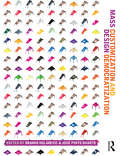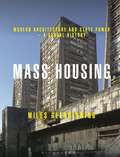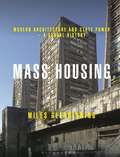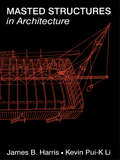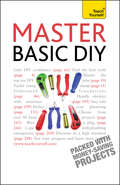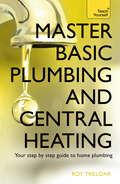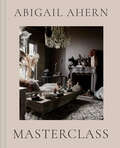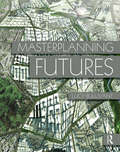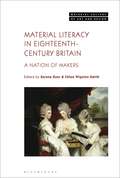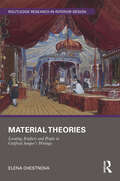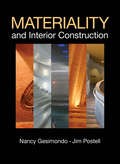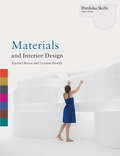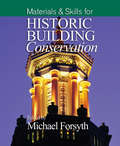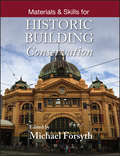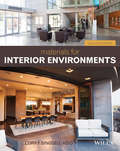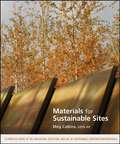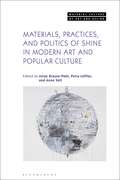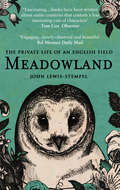- Table View
- List View
Mass Customization and Design Democratization
by Branko Kolarevic José Pinto DuarteParametric design and digital fabrication are enabling non-designers to mass produce non-standard, highly differentiated products – from shoes and tableware to furniture and even houses. The result of these newly available mass customization tools has been a ‘democratization’ of design. Mass Customization and Design Democratization is the first book to address this recent phenomenon. Demonstrating how the considerable potential of these tools can be realized in practice, it introduces essential technologies and design approaches and provides numerous examples of the latest, cutting edge work from leading design firms, manufacturers and thinkers. The book examines what mass customization means for architecture and the building industry and investigates its impact on the sector’s most commoditized enterprise – suburban housing. Asking whether design democratization is viable in the current context and exploring what kind of mass customization is possible, useful, and desirable, it poses fundamental questions about the authorship of design and the functional and aesthetic quality of products designed by non-designers. A highly designed book featuring over 200 color illustrations, this is essential reading for professionals as well as students taking courses in digital architecture, parametric design, and mass customization.
Mass Housing: Modern Architecture and State Power – a Global History
by Miles GlendinningThis major work provides the first comprehensive history of one of modernism's most defining and controversial architectural legacies: the 20th-century drive to provide 'homes for the people'. Vast programmes of mass housing – high-rise, low-rise, state-funded, and built in the modernist style – became a truly global phenomenon, leaving a legacy which has suffered waves of disillusionment in the West but which is now seeing a dramatic, 21st-century renaissance in the booming, crowded cities of East Asia. Providing a global approach to the history of Modernist mass-housing production, this authoritative study combines architectural history with the broader social, political, cultural aspects of mass housing – particularly the 'mass' politics of power and state-building throughout the 20th century. Exploring the relationship between built form, ideology, and political intervention, it shows how mass housing not only reflected the transnational ideals of the Modernist project, but also became a central legitimizing pillar of nation-states worldwide. In a compelling narrative which likens the spread of mass housing to a 'Hundred Years War' of successive campaigns and retreats, it traces the history around the globe from Europe via the USA, Soviet Union and a network of international outposts, to its ultimate, optimistic resurgence in China and the East – where it asks: Are we facing a new dawn for mass housing, or another 'great housing failure' in the making?
Mass Housing: Modern Architecture and State Power – a Global History
by Miles GlendinningThis major work provides the first comprehensive history of one of modernism's most defining and controversial architectural legacies: the 20th-century drive to provide 'homes for the people'. Vast programmes of mass housing – high-rise, low-rise, state-funded, and built in the modernist style – became a truly global phenomenon, leaving a legacy which has suffered waves of disillusionment in the West but which is now seeing a dramatic, 21st-century renaissance in the booming, crowded cities of East Asia. Providing a global approach to the history of Modernist mass-housing production, this authoritative study combines architectural history with the broader social, political, cultural aspects of mass housing – particularly the 'mass' politics of power and state-building throughout the 20th century. Exploring the relationship between built form, ideology, and political intervention, it shows how mass housing not only reflected the transnational ideals of the Modernist project, but also became a central legitimizing pillar of nation-states worldwide. In a compelling narrative which likens the spread of mass housing to a 'Hundred Years War' of successive campaigns and retreats, it traces the history around the globe from Europe via the USA, Soviet Union and a network of international outposts, to its ultimate, optimistic resurgence in China and the East – where it asks: Are we facing a new dawn for mass housing, or another 'great housing failure' in the making?
Masted Structures in Architecture
by James Harris Kevin LiThis is the first fully comprehensive survey and analysis of masted structures and covers examples that have evolved during the past three decades.Masted Structures are one of the most interesting developments in post-war architecture resulting from a combination of technology, structural engineering theory and a collaboration between architects and engineers. This is an essential guide for architects to the structural and constructional implications of masted forms in relation to space enclosure, patterns of loading and use of differing materials and techniques. This useful volume will enable architects and engineers to understand the origins, development and nature of masted structures and will provide a stimulating basis for future design.
Masted Structures in Architecture
by James Harris Kevin LiThis is the first fully comprehensive survey and analysis of masted structures and covers examples that have evolved during the past three decades.Masted Structures are one of the most interesting developments in post-war architecture resulting from a combination of technology, structural engineering theory and a collaboration between architects and engineers. This is an essential guide for architects to the structural and constructional implications of masted forms in relation to space enclosure, patterns of loading and use of differing materials and techniques. This useful volume will enable architects and engineers to understand the origins, development and nature of masted structures and will provide a stimulating basis for future design.
Master Basic DIY: Teach Yourself (Teach Yourself - General Ser.)
by DIY DoctorMaster Basic DIY explains all the basic tasks and gives you all the information you need to undertake essential decorating and maintenance in an informed and sensible manner. It offers insight into complex options and methods, and is full of practical information and indispensable tips to enable you to quickly see the results reflected in your DIY projects.NOT GOT MUCH TIME?One, five and ten-minute introductions to key principles to get you started.AUTHOR INSIGHTSLots of instant help with common problems and quick tips for success, based on the author's many years of experience.TEST YOURSELFTests in the book and online to keep track of your progress.EXTEND YOUR KNOWLEDGEExtra online articles at www.teachyourself.com to give you a richer understanding of basic DIY.FIVE THINGS TO REMEMBERQuick refreshers to help you remember the key facts.TRY THISInnovative exercises illustrate what you've learnt and how to use it.
Master Basic Plumbing And Central Heating: A quick guide to plumbing and heating jobs, including basic emergency repairs (Teach Yourself)
by Roy TreloarThis guide to the basics of plumbing and central heating is designed for complete amateurs, and written by one of the most experienced plumbing tutors in the country.Whether you are attempting projects such as installing a new bathroom or plumbing in a new dishwasher, or just need to understand enough to do essential repairs and fixes, this is the book for you. It includes step-by-step guides to sorting out the most common plumbing problems, and comprehensive coverage of the key tasks, all based on a straightforward introduction to the layout of your house and water system. In addition, it has plenty of illustrations, a full glossary, a whole chapter on how and who to call for help, a guide to the necessary toolkit and a list of the top ten plumbing emergencies.
Masterclass
by Abigail AhernThe new book from interior design powerhouse Abigail Ahern, Her Masterclass is based on the building blocks that will make your home look great: seating, lighting, walls, floors and accessories. Abigail demonstrates her style perfectly with original location photography and case studies of fabulous homes.
Masterplanning Futures
by Lucy BullivantWinner of the Urban Design Group's 2014 Book of the Year Award! In the past, spatial masterplans for cities have been fixed blueprints realized as physical form through conventional top down processes. These frequently disregarded existing social and cultural structures, while the old modernist planning model zoned space for home and work. At a time of urban growth, these models are now being replaced by more adaptable, mixed use plans dealing holistically with the physical, social and economic revival of districts, cities and regions. Through today’s public participative approaches and using technologically enabled tools, contemporary masterplanning instruments embody fresh principles, giving cities a greater resilience and capacity for social integration and change in the future. Lucy Bullivant analyses the ideals and processes of international masterplans, and their role in the evolution of many different types of urban contexts in both the developed and developing world. Among the book’s key themes are landscape-driven schemes, social equity through the reevaluation of spatial planning, and the evolution of strategies responding to a range of ecological issues and the demands of social growth. Drawing on first-hand accounts and illustrated throughout with colour photographs, plans and visualizations, the book includes twenty essays introduced by an extensive overview of the field and its objectives. These investigate plans including one-north Singapore, Masdar City in Abu Dhabi, Xochimilco in Mexico City and Waterfront Seattle, illuminating their distinct yet complementary integrated strategies. This is a key book for those interested in today’s multiscalar masterplanning and conceptually advanced methodologies and principles being applied to meet the challenges and opportunities of the urbanizing world. The author's research was enabled by grants from the Commission for Architecture and the Built Environment (CABE), the SfA (the Netherlands Architecture Fund), the Danish Embassy and support from the Alfred Herrhausen Society.
Masterplanning Futures
by Lucy BullivantWinner of the Urban Design Group's 2014 Book of the Year Award! In the past, spatial masterplans for cities have been fixed blueprints realized as physical form through conventional top down processes. These frequently disregarded existing social and cultural structures, while the old modernist planning model zoned space for home and work. At a time of urban growth, these models are now being replaced by more adaptable, mixed use plans dealing holistically with the physical, social and economic revival of districts, cities and regions. Through today’s public participative approaches and using technologically enabled tools, contemporary masterplanning instruments embody fresh principles, giving cities a greater resilience and capacity for social integration and change in the future. Lucy Bullivant analyses the ideals and processes of international masterplans, and their role in the evolution of many different types of urban contexts in both the developed and developing world. Among the book’s key themes are landscape-driven schemes, social equity through the reevaluation of spatial planning, and the evolution of strategies responding to a range of ecological issues and the demands of social growth. Drawing on first-hand accounts and illustrated throughout with colour photographs, plans and visualizations, the book includes twenty essays introduced by an extensive overview of the field and its objectives. These investigate plans including one-north Singapore, Masdar City in Abu Dhabi, Xochimilco in Mexico City and Waterfront Seattle, illuminating their distinct yet complementary integrated strategies. This is a key book for those interested in today’s multiscalar masterplanning and conceptually advanced methodologies and principles being applied to meet the challenges and opportunities of the urbanizing world. The author's research was enabled by grants from the Commission for Architecture and the Built Environment (CABE), the SfA (the Netherlands Architecture Fund), the Danish Embassy and support from the Alfred Herrhausen Society.
Material Literacy in Eighteenth-Century Britain: A Nation of Makers (Material Culture of Art and Design)
by Edited by Serena Dyer and Chloe Wigston SmithThe eighteenth century has been hailed for its revolution in consumer culture, but Material Literacy in Eighteenth-Century Britain repositions Britain as a nation of makers. It brings new attention to eighteenth-century craftswomen and men with its focus on the material knowledge possessed not only by professional artisans and amateur makers, but also by skilled consumers. This edited collection gathers together a group of interdisciplinary scholars working in the fields of art history, history, literature, and museum studies to unearth the tactile and tacit knowledge that underpinned fashion, tailoring, and textile production. It invites us into the workshops, drawing rooms, and backrooms of a broad range of creators, and uncovers how production and tacit knowledge extended beyond the factories and machines which dominate industrial histories. This book illuminates, for the first time, the material literacies learnt, enacted, and understood by British producers and consumers. The skills required for sewing, embroidering, and the textile arts were possessed by a large proportion of the British population: men, women and children, professional and amateur alike. Building on previous studies of shoppers and consumption in the period, as well as narratives of manufacture, these essays document the multiplicity of small producers behind Britain's consumer revolution, reshaping our understanding of the dynamics between making and objects, consumption and production. It demonstrates how material knowledge formed an essential part of daily life for eighteenth-century Britons. Craft technique, practice, and production, the contributors show, constituted forms of tactile languages that joined makers together, whether they produced objects for profit or pleasure.
Material Literacy in Eighteenth-Century Britain: A Nation of Makers (Material Culture of Art and Design)
The eighteenth century has been hailed for its revolution in consumer culture, but Material Literacy in Eighteenth-Century Britain repositions Britain as a nation of makers. It brings new attention to eighteenth-century craftswomen and men with its focus on the material knowledge possessed not only by professional artisans and amateur makers, but also by skilled consumers. This edited collection gathers together a group of interdisciplinary scholars working in the fields of art history, history, literature, and museum studies to unearth the tactile and tacit knowledge that underpinned fashion, tailoring, and textile production. It invites us into the workshops, drawing rooms, and backrooms of a broad range of creators, and uncovers how production and tacit knowledge extended beyond the factories and machines which dominate industrial histories. This book illuminates, for the first time, the material literacies learnt, enacted, and understood by British producers and consumers. The skills required for sewing, embroidering, and the textile arts were possessed by a large proportion of the British population: men, women and children, professional and amateur alike. Building on previous studies of shoppers and consumption in the period, as well as narratives of manufacture, these essays document the multiplicity of small producers behind Britain's consumer revolution, reshaping our understanding of the dynamics between making and objects, consumption and production. It demonstrates how material knowledge formed an essential part of daily life for eighteenth-century Britons. Craft technique, practice, and production, the contributors show, constituted forms of tactile languages that joined makers together, whether they produced objects for profit or pleasure.
Material Theories: Locating Artefacts and People in Gottfried Semper's Writings (Routledge Research in Interior Design)
by Elena ChestnovaMaterial Theories takes a radically new approach to well-established thinking on nineteenth-century architecture and design by investigating Gottfried Semper’s classic ideas about dressing, metamorphosis of material, and cultural development, culminating in his two-volume publication Style. This book demonstrates how Semper’s theories crystallised among his encounters with material things of the late 1840s and early 1850s. It examines several discursive frameworks and phenomena which shaped the attitude to artefacts in Europe in the mid-nineteenth century, and which were specifically pertinent to Semper’s evolution: archaeology and antiquarianism, the domestic interior, print media, collections, and the embodied relationship between the designer and their work. For the first time, this book examines the construction of a design theory not only as an intellectual endeavour but also as a process of confrontation with material things. It employs recent approaches to material culture, in particular Thing Theory, in order to show that Semper’s artefact references constituted his ideas, rather than simply giving impetus to them. It will be an important investigation for academics and researchers interested in interior design history, as well as scholars of material culture and history of design theory.
Material Theories: Locating Artefacts and People in Gottfried Semper's Writings (Routledge Research in Interior Design)
by Elena ChestnovaMaterial Theories takes a radically new approach to well-established thinking on nineteenth-century architecture and design by investigating Gottfried Semper’s classic ideas about dressing, metamorphosis of material, and cultural development, culminating in his two-volume publication Style. This book demonstrates how Semper’s theories crystallised among his encounters with material things of the late 1840s and early 1850s. It examines several discursive frameworks and phenomena which shaped the attitude to artefacts in Europe in the mid-nineteenth century, and which were specifically pertinent to Semper’s evolution: archaeology and antiquarianism, the domestic interior, print media, collections, and the embodied relationship between the designer and their work. For the first time, this book examines the construction of a design theory not only as an intellectual endeavour but also as a process of confrontation with material things. It employs recent approaches to material culture, in particular Thing Theory, in order to show that Semper’s artefact references constituted his ideas, rather than simply giving impetus to them. It will be an important investigation for academics and researchers interested in interior design history, as well as scholars of material culture and history of design theory.
Materiality and Interior Construction
by Jim Postell Nancy GesimondoA comprehensive reference of materials for interior designers and architects Choosing the right material for the right purpose is a critical—and often overlooked—aspect in the larger context of designing buildings and interior spaces. When specified and executed properly, materials support and enhance a project's overall theme, and infuse interior space with a solid foundation that balances visual poetry and functionality. Materiality and Interior Construction imparts essential knowledge on how materials contribute to the construction and fabrication of floors, partitions, ceilings, and millwork, with thorough coverage of the important characteristics and properties of building materials and finishes. Individual coverage of the key characteristics of each material explores the advantages and disadvantages of using specific materials and construction assemblies, while helping readers discover how to make every building element count. In addition, Materiality and Interior Construction: Is highly illustrated throughout to show material properties and building assemblies Supplies rankings and information on the "green" attributes of each material so that designers can make informed decisions for specifications Is organized by application for easy and quick access to information Includes a companion website, featuring an extensive online image bank of materials and assemblies Rather than a typical catalog of materials, Materiality and Interior Construction is efficiently organized so that the reader is guided directly to the options for the location or assembly they are considering. Reliable and easy to use, Materiality and Interior Construction is a one-stop, comprehensive reference for hundreds of commonly used materials and their integration as building components—and an invaluable resource that every interior designer or architect should add to their set of tools.
Materiality and Interior Construction
by Jim Postell Nancy GesimondoA comprehensive reference of materials for interior designers and architects Choosing the right material for the right purpose is a critical—and often overlooked—aspect in the larger context of designing buildings and interior spaces. When specified and executed properly, materials support and enhance a project's overall theme, and infuse interior space with a solid foundation that balances visual poetry and functionality. Materiality and Interior Construction imparts essential knowledge on how materials contribute to the construction and fabrication of floors, partitions, ceilings, and millwork, with thorough coverage of the important characteristics and properties of building materials and finishes. Individual coverage of the key characteristics of each material explores the advantages and disadvantages of using specific materials and construction assemblies, while helping readers discover how to make every building element count. In addition, Materiality and Interior Construction: Is highly illustrated throughout to show material properties and building assemblies Supplies rankings and information on the "green" attributes of each material so that designers can make informed decisions for specifications Is organized by application for easy and quick access to information Includes a companion website, featuring an extensive online image bank of materials and assemblies Rather than a typical catalog of materials, Materiality and Interior Construction is efficiently organized so that the reader is guided directly to the options for the location or assembly they are considering. Reliable and easy to use, Materiality and Interior Construction is a one-stop, comprehensive reference for hundreds of commonly used materials and their integration as building components—and an invaluable resource that every interior designer or architect should add to their set of tools.
Materials and Interior Design (Portfolio Skills)
by Lorraine Farrelly Rachael BrownThe choice of materials is critical to the success of an interior. This book examines every aspect of the the use of materials in interior design, from initial concept and selection to visual representation and practical application. Following a brief introduction, the first five sections offer historical context and detailed guidance on selection, application, representation, communication, and sources, while the sixth and final section features case studies by international interior designers. The book includes useful step-by-step sequences, information on properties and sustainability, and a list of resources, online archives and sample libraries. It is an invaluable practical and inspirational guide for interior design students.
Materials and Skills for Historic Building Conservation (Historic Building Conservation)
by Michael ForsythThis book is the third in a series of volumes that combine conservation philosophy in the built environment with knowledge of traditional materials, and structural and constructional conservation techniques and technology: Understanding Historic Building Conservation Structures & Construction in Historic Building Conservation Materials & Skills for Historic Building Conservation The series aims to introduce each aspect of conservation and to provide concise, basic and up-to-date knowledge for architects, surveyors and engineers as well as for commissioning client bodies, managers and advisors. In each book, Michael Forsyth draws together chapters by leading architects, structural engineers and related professionals to reflect the interdisciplinary nature of conservation work. The books are structured to be of direct practical application, taking the reader through the process of historic building conservation and emphasising throughout the integrative teamwork involved. The present volume - Materials & Skills for Historic Building Conservation – describes the characteristics and process of decay of traditional materials which inform the selection of appropriate repair techniques. It provides essential information on the properties of the principal traditional external building materials. Their availability, sourcing and environmental impact is covered, as well as the causes of erosion and decay, and the skills required for their application on conservation projects. It covers the main most commonly used materials and conservation techniques including stone, brickwork, lime products, concrete, iron and steel, timber, wattle and daub, and glass, Thirteen chapters written by the experts present today's key issues in materials and skills for historic building conservation: Gus Astley, Patrick Baty, Charley Brentnall, Michael Bussell, Michael Forsyth, Tony Graham, Chris Harris, David McLaughlin, Brian Ridout, Mike Stock, Geoff Wallis, Ian Williams, Rory Young
Materials and Skills for Historic Building Conservation (Historic Building Conservation)
by Michael ForsythThis book is the third in a series of volumes that combine conservation philosophy in the built environment with knowledge of traditional materials, and structural and constructional conservation techniques and technology: Understanding Historic Building Conservation Structures & Construction in Historic Building Conservation Materials & Skills for Historic Building Conservation The series aims to introduce each aspect of conservation and to provide concise, basic and up-to-date knowledge for architects, surveyors and engineers as well as for commissioning client bodies, managers and advisors. In each book, Michael Forsyth draws together chapters by leading architects, structural engineers and related professionals to reflect the interdisciplinary nature of conservation work. The books are structured to be of direct practical application, taking the reader through the process of historic building conservation and emphasising throughout the integrative teamwork involved. The present volume - Materials & Skills for Historic Building Conservation – describes the characteristics and process of decay of traditional materials which inform the selection of appropriate repair techniques. It provides essential information on the properties of the principal traditional external building materials. Their availability, sourcing and environmental impact is covered, as well as the causes of erosion and decay, and the skills required for their application on conservation projects. It covers the main most commonly used materials and conservation techniques including stone, brickwork, lime products, concrete, iron and steel, timber, wattle and daub, and glass, Thirteen chapters written by the experts present today's key issues in materials and skills for historic building conservation: Gus Astley, Patrick Baty, Charley Brentnall, Michael Bussell, Michael Forsyth, Tony Graham, Chris Harris, David McLaughlin, Brian Ridout, Mike Stock, Geoff Wallis, Ian Williams, Rory Young
Materials for Interior Environments
by Corky BinggeliOrganized by types of materials and applications, this guide helps designers successfully address material evaluation and selection of interior components. Engagingly written, highly detailed, and helpfully illustrated with more than 550 color illustrations, Materials for Interior Environments is a comprehensive guide to everything a designer needs to know about the materials available for interiors—from aesthetic qualities to manufacturing and fabrication, applications, installation and maintenance, and specifications for materials used in commercial and residential applications.
Materials for Interior Environments
by Corky BinggeliOrganized by types of materials and applications, this guide helps designers successfully address material evaluation and selection of interior components. Engagingly written, highly detailed, and helpfully illustrated with more than 550 color illustrations, Materials for Interior Environments is a comprehensive guide to everything a designer needs to know about the materials available for interiors—from aesthetic qualities to manufacturing and fabrication, applications, installation and maintenance, and specifications for materials used in commercial and residential applications.
Materials for Sustainable Sites: A Complete Guide to the Evaluation, Selection, and Use of Sustainable Construction Materials
by Meg CalkinsThis complete guide to the evaluation, selection, and use of sustainable materials in the landscape features strategies to minimize environmental and human health impacts of conventional site construction materials as well as green materials. Providing detailed current information on construction materials for sustainable sites, the book introduces tools, techniques, ideologies and resources for evaluating, sourcing, and specifying sustainable site materials. Chapters cover types of materials, both conventional and emerging green materials, environmental and human health impacts of the material, and detailed strategies to minimize these impacts. Case studies share cost and performance information and lessons learned.
Materials, Practices, and Politics of Shine in Modern Art and Popular Culture (Material Culture of Art and Design)
by Antje Krause-Wahl, Petra Löffler and Änne SöllShine allures and awakens desire. As a phenomenon of perception shiny things and materials fascinate and tantalize. They are a formative element of material culture, promising luxury, social distinction and the hope of limitless experience and excess. Since the early twentieth century the mass production, dissemination and popularization of synthetic materials that produce heretofore-unknown effects of shine have increased. At the same time, shine is subjectified as “glamor” and made into a token of performative self-empowerment. The volume illuminates genealogical as well as systematic relationships between material phenomena of shine and cultural-philosophical concepts of appearance, illusion, distraction and glare in bringing together renowned scholars from various disciplines.
Materials, Practices, and Politics of Shine in Modern Art and Popular Culture (Material Culture of Art and Design)
Shine allures and awakens desire. As a phenomenon of perception shiny things and materials fascinate and tantalize. They are a formative element of material culture, promising luxury, social distinction and the hope of limitless experience and excess. Since the early twentieth century the mass production, dissemination and popularization of synthetic materials that produce heretofore-unknown effects of shine have increased. At the same time, shine is subjectified as “glamor” and made into a token of performative self-empowerment. The volume illuminates genealogical as well as systematic relationships between material phenomena of shine and cultural-philosophical concepts of appearance, illusion, distraction and glare in bringing together renowned scholars from various disciplines.
Meadowland: the private life of an English field
by John Lewis-StempelWINNER OF THE THWAITES WAINWRIGHT PRIZE 2015What really goes on in the long grass?Meadowland gives an unique and intimate account of an English meadow’s life from January to December, together with its biography. In exquisite prose, John Lewis-Stempel records the passage of the seasons from cowslips in spring to the hay-cutting of summer and grazing in autumn, and includes the biographies of the animals that inhabit the grass and the soil beneath: the badger clan, the fox family, the rabbit warren,the skylark brood and the curlew pair, among others. Their births, lives, and deaths are stories that thread through the book from first page to last.
